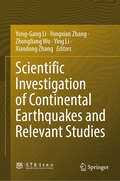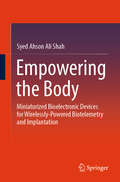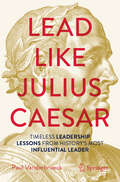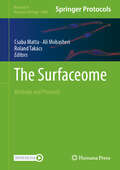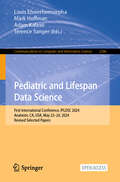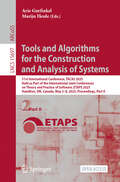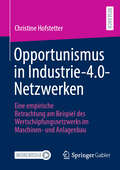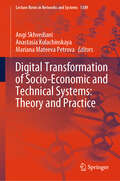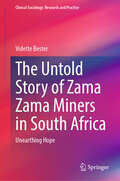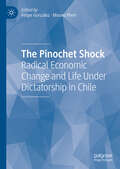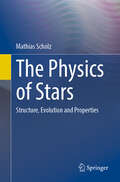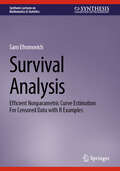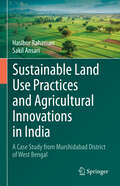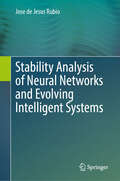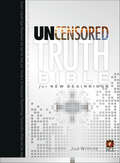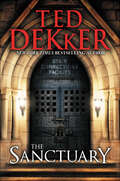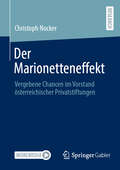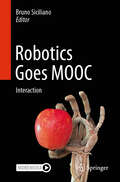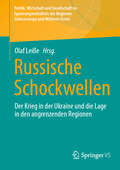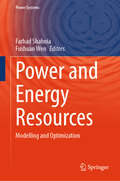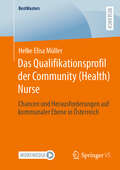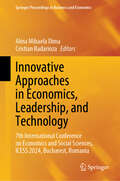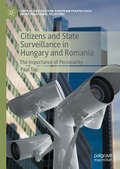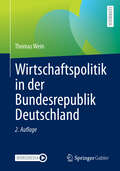- Table View
- List View
Scientific Investigation of Continental Earthquakes and Relevant Studies
by Ying Li Zhongliang Wu Yongxian Zhang Yong-Gang Li Xiaodong ZhangThis book focuses on seismogenic and tectonic environments, seismogenic structures, seismogenic fault structures, earthquake physics, rupture dynamic process, source mechanism, earthquake seismic anomalies and risk assessment, exploration of prediction methods, earthquake disaster characteristics and disaster-causing mechanisms, ground motion prediction, as well as state-of-the-art techniques.
Empowering the Body: Miniaturized Bioelectronic Devices for Wirelessly-Powered Biotelemetry and Implantation
by Syed Ahson ShahEmbark on a groundbreaking journey into the realm of miniaturized bioelectronic devices with "Empowering the Body." This captivating book delves into the world of wirelessly-powered biotelemetry and implantation, offering unparalleled insights into the future of healthcare monitoring. Discover the motivations driving the development of wireless implantable medical devices (WIMDs) and the challenges faced in their design. Unravel the mysteries behind biocompatibility, size miniaturization, patient safety, and impedance mismatches. Witness the innovative solutions that optimize performance and extend battery life, all while ensuring the utmost precision in therapy and treatment. Featuring state-of-the-art research, this book showcases cutting-edge advancements in miniaturized implantable antenna systems, ultra-small batteryless WIMDs, and deeply implanted stent antenna systems for endovascular aneurysm repair. Immerse yourself in a world of simulations, numerical analyses, and validation experiments, where the proposed systems are rigorously tested and proven to excel in heterogeneous human body tissue environments. "Empowering the Body" caters to a diverse audience of researchers, engineers, and medical professionals at the forefront of bioelectronic devices and wireless power transfer. Whether you're an expert in the field or a graduate student seeking knowledge, this book is your key to unlocking the potential of wireless healthcare solutions. Open the pages of this exceptional book and explore its unique approach, combining theoretical insights with practical applications. Gain a comprehensive understanding of how to overcome the limitations of current technologies, and be inspired by the possibilities that lie ahead. Don't miss your chance to be at the forefront of the biomedical revolution with "Empowering the Body."
Lead Like Julius Caesar: Timeless Leadership Lessons from History's Most Influential Leader
by Paul VanderbroeckDiscover the legendary life and career of Julius Caesar in this insightful and thought-provoking book that breaks down the bold strategies, leadership skills, and motivations behind his rise to power. Beyond his triumphs, the book examines the cautionary tale of his downfall, offering timeless lessons for managers, leaders, and business students to reflect on and benchmark their careers. Through a modern lens – by applying leadership theories – this book explores Caesar's personal traits, relationships, and decisions that shaped his leadership, providing insights into his competencies and the factors behind his meteoric rise. It's a valuable case study for organizations aiming to develop strong leaders and teams, making it a must-read for history enthusiasts, professionals, and anyone seeking practical strategies for success. For managers, leaders, professionals, and business students alike, this book offers a unique opportunity to reflect on their careers and benchmark their success and ambition against one of the greatest leaders of all time.
The Surfaceome: Methods and Protocols (Methods in Molecular Biology #2908)
by Ali Mobasheri Csaba Matta Roland TakácsThis volume explores a collection of methodologies used to study the complexities of biological membranes and the associated surfaceome. The chapters in this book aim to facilitate the adoption of innovative methods to help researchers advance their understanding of the biology of membranes and their role in health and disease. Written in the highly successful Methods in Molecular Biology series format, chapters include introductions to their respective topics, lists of the necessary materials and reagents, step-by-step, readily reproducible laboratory protocols, and tips on trouble shooting and avoiding known pitfalls.Comprehensive and cutting-edge, The Surfaceome: Methods and Protocols is a valuable resource for both novice and expert researchers looking to learn more about this important and developing field.
Pediatric and Lifespan Data Science: First International Conference, IPLDSC 2024, Anaheim, CA, USA, May 23–24, 2024, Revised Selected Papers (Communications in Computer and Information Science #2386)
by Mark Hoffman Louis Ehwerhemuepha Adam Kalawi Terence SangerThis open access book will address the unique requirements and technological tools for analysis of data across the lifespan, from childhood through advanced age. Topics such as sepsis, hospital-acquired infections, mental health, health equity, precision medicine, large language models and generative artificial intelligence, computer vision, ethical use of artificial intelligence, and large real-world electronic health record databases will be covered.
Tools and Algorithms for the Construction and Analysis of Systems: 31st International Conference, TACAS 2025, Held as Part of the International Joint Conferences on Theory and Practice of Software, ETAPS 2025, Hamilton, ON, Canada, May 3–8, 2025, Proceedings, Part II (Lecture Notes in Computer Science #15697)
by Arie Gurfinkel Marijn HeuleThe open access book set LNCS 15696, 15697 and 15698 constitutes the proceedings of the 31st International Conference on Tools and Algorithms for the Construction and Analysis of Systems, TACAS 2025, which was held as part of the International Joint Conferences on Theory and Practice of Software, ETAPS 2025, during May 3-8, 2025, in Hamilton, Canada. The 46 papers presented were carefully reviewed and selected from 148 submissions. The proceedings also include 14 papers from the Software Verification competition which was held as part of TACAS. The papers were organized in topical sections as follows: Part I: Program analysis, ATP and rewriting; model checking; LTL; verification; Part II: SAT and SMT solving; proofs and certificates; synthesis; equivalence checking; games; Part III: Verification; quantum and GPU; 14th Competition on Software Verification, SV-COMP 2025.
Opportunismus in Industrie-4.0-Netzwerken: Eine empirische Betrachtung am Beispiel des Wertschöpfungsnetzwerks im Maschinen- und Anlagenbau
by Christine HofstetterInnerhalb zwischenbetrieblicher Beziehungen gilt Opportunismus seit jeher als zentrales Problem, das trotz großer Forschungsbemühungen noch viele Fragen aufwirft. Erschwerend kommt hinzu, dass Industrie 4.0 weitreichende Veränderungen in den Wertschöpfungsarchitekturen mit sich bringt. Die Wissenschaft hat die Erforschung von Opportunismus in der sich neu herausbildenden Netzwerkumgebung jedoch vernachlässigt. Das vorliegende Buch untersucht unter Zuhilfenahme relevanter Theorien die den Opportunismus betreffenden Wirkungen ausgewählter Determinanten (strukturelle Einbettung, externe Unsicherheit, Abhängigkeit, distributive Ungerechtigkeit, Einsatz von Verträgen, intrinsische Motivation, gemeinsame Beziehungserfahrung) und ihr Zusammenspiel mit dem Moderator Sozialkapital in einer Industrie-4.0-Netzwerkumgebung. Unter Rückbesinnung auf Theorien aus der Psychologie und Soziologie werden zudem die jeweiligen Opportunismusadressaten identifiziert, welche in der dyadischen Forschung naturgemäß offensichtlich waren. Eine qualitativ-empirische Untersuchung von sechs Wertschöpfungsnetzwerken im Industriegütermarkt stützt nicht nur die getätigten Vorannahmen, sondern bringt auch eine völlig neue Größe ins Spiel: das Ökonomische Kapital.
Digital Transformation of Socio-Economic and Technical Systems: Theory and Practice (Lecture Notes in Networks and Systems #1309)
by Angi Skhvediani Mariana Mateeva Petrova Anastasia KulachinskayaIn the theoretical field, this book presents innovative concepts and models that elucidate the dynamics and implications of digitalization across diverse socio-economic systems. Additionally, from a practical perspective, the book offers real-world examples and case studies that illustrate successful strategies for implementing digital technologies and their contributions to the sustainable development of various industries. In recent years, digital economy has become a key driver, which fosters growth of various systems. The COVID-19 pandemic has additionally boosted this process and resulted in higher effectiveness of both formal and informal institutes, structural changes on labour market, new opportunities for social mobility, new markets, new forms of interaction between government, individuals, and enterprises. On the other hand, these processes entailed significant challenges among which are digital divide, cyber security, high costs of process digitalization, etc. This book is designed for researchers, educators, students, and practitioners interested in acquiring profound insights into the contemporary processes of digital transformation and their impact on socio-economic and technical systems.
The Untold Story of Zama Zama Miners in South Africa: Unearthing Hope (Clinical Sociology: Research and Practice)
by Vidette BesterThis book results from a decade of in-depth research on the complexities of Zama Zama mining in South Africa, which has become a pressing issue of late. It critiques the overly simplistic portrayal of the miners negatively and as illegal immigrants. Through a sociological lens, this book explores the broader socio-economic conditions, the profound impact of South Africa&’s mining history, particularly the migrant labor system, on today&’s Zama Zama miners, and the role of women in the sector. This book is not just about mining; it interrogates issues around language, poverty, and power. It challenges dominant societal narratives and examines how labels can further marginalize vulnerable groups. Inspired by the works of Pierre Bourdieu and Michel Foucault on classification and language, the book questions who holds the power to label and shape mainstream discourses. Amplifying the voices of the Zama Zamas themselves, the book transforms the conversation around Zama Zama mining in South Africa and beyond, providing fresh insights into this complex and marginalized sector. This book is more than an original and insightful study on informal mining – it offers practical initiatives for businesses, government, and civil society to engage with and address this marginalized sector more sustainably.
The Pinochet Shock: Radical Economic Change and Life Under Dictatorship in Chile
by Felipe González Mounu PremThis book explores the economic and political transformation of Chile under the Augusto Pinochet dictatorship. It highlights how radical change, in this case the arrival of an authoritarian regime, takes place, as well as the impact it has upon citizens and the disruptions it has on everyday life. Through examining how conservative and market-based reforms were introduced to fight socialist ideas and stimulate the private sector, a framework is created for understanding the long-term economic, political, and social impact of the Pinochet dictatorship. Particular attention is given to the consequences of state-led repression, local governments, higher education, the privatization of state-owned businesses, the labor market, censorship, and indigenous policies, among others. This book provides a multidisciplinary perspective on the reforms seen in Chile under Pinochet and brings together ideas from economics, history, political science, sociology, and regional studies. It will be relevant to students and researchers interested in the political economy and history of Chile and Latin America.
Modeling of Z-pinned Carbon Fiber-Reinforced Polymer (CFRP) Composite: Curing Process and Mechanical Properties
by Weihong Zhang Yingjie XuThis book attempts to develop an integrative method that combines the processing and mechanical simulations for z-pinned carbon fiber-reinforced polymer (CFRP) composites. The topics in this book cover experimental characterization, processing modeling, mechanical simulation, and the integrated analysis method for z-pinned CFRP composites. Explanations are made in detail about how to combine the processing induced residual stress and z-pin/composite interfacial debonding with tensile strength, failure mode, and bridging tractions modeling and simulations for z-pinned CFRP composites. This book is considered as a complementary work of existing books about composites mechanics and processing. This book is used as a guideline for graduate students and research engineers who wish to learn the basic modeling techniques in processing and characterizing z-pinned CFRP composites. For reading the book, readers will need the technical background of mechanics and finite element method.
The Physics of Stars: Structure, Evolution and Properties
by Mathias ScholzInterested students in the natural and engineering sciences, as well as high school graduates, instructors, teachers, and amateur astronomers, will find a valuable overview of the physics of stars in this book. The only prerequisite is a basic mathematical and physical background, which does not go beyond the knowledge of integral and differential calculus. In this regard, this book aims to bridge the gap with the specialized literature available on the internet, allowing readers to benefit from it. The first part traces the historical development that led to a detailed understanding of the nature of stars and their life cycles. The goal of the following chapters is to provide a pragmatic introduction to the physical processes that determine the structure and evolution of stars based on their fundamental parameters such as mass and chemical composition. It will show what can be learned from the analysis of starlight about stellar atmospheres, the fundamental role of the virial theorem in the lives of stars, and the nuclear processes deep inside stars that provide the energy that makes them shine. Finally, there will be an in-depth phenomenological look at the final stages of stellar evolution. This section will discuss states of matter that are far from experimental realization but whose properties can be, at least in principle, inferred from the observation of concrete objects such as white dwarfs or neutron stars. Exciting developments are still expected in this area in the future. Mathias Scholz is hobby astronomer. He studied physics at the University of Rostock from 1981 to 1986. Interested students in the natural and engineering sciences, as well as high school graduates, instructors, teachers, and amateur astronomers, will find a valuable overview of the physics of stars in this book. The only prerequisite is a basic mathematical and physical background, which does not go beyond the knowledge of integral and differential calculus. In this regard, this book aims to bridge the gap with the specialized literature available on the internet, allowing readers to benefit from it. The first part traces the historical development that led to a detailed understanding of the nature of stars and their life cycles. The goal of the following chapters is to provide a pragmatic introduction to the physical processes that determine the structure and evolution of stars based on their fundamental parameters such as mass and chemical composition. It will show what can be learned from the analysis of starlight about stellar atmospheres, the fundamental role of the virial theorem in the lives of stars, and the nuclear processes deep inside stars that provide the energy that makes them shine. Finally, there will be an in-depth phenomenological look at the final stages of stellar evolution. This section will discuss states of matter that are far from experimental realization but whose properties can be, at least in principle, inferred from the observation of concrete objects such as white dwarfs or neutron stars. Exciting developments are still expected in this area in the future.
Survival Analysis: Efficient Nonparametric Curve Estimation For Censored Data with R Examples (Synthesis Lectures on Mathematics & Statistics)
by Sam EfromovichThis textbook provides a unified account of estimating the survival function, hazard rate, cumulative hazard, density, regression, conditional distributions, and linear functionals for the current status censored and right-censored data. The book contains the theory and methodology of efficient estimation, adaptation, dimension reduction, and confidence bands as well as the universal E-estimator for small samples. Exercises and a large number of simulated and real-life examples that can be repeated and modified using the complementary R package are also included. This coverage, together with the intuitive style of presentation, is ideal for people entering this field. The context is suitable for self-study or a one-semester course for graduate students with majors ranging from biostatistics and data analytics to econometrics and actuarial science.
Sustainable Land Use Practices and Agricultural Innovations in India: A Case Study from Murshidabad District of West Bengal
by Hasibur Rahaman Sakil AnsariThis book discusses sustainable land use practices in relation to agricultural innovation, with a local focus by land size classes on the Murshidabad District of West Bengal. Chapter 1 presents the different aspects of the physical and cultural set-up of the Murshidabad district. Chapter 2 provides a background and overview of sustainable agricultural land use and development. Chapter 3 presents the dynamics of sustainable agricultural land use and cropping patterns at the local level. Chapter 4 discusses the overall agricultural innovations concerning the input and output aspects of a spatial context under different land size classes. Chapter 5 covers the relationship between sustained agricultural land use and agricultural innovations. Chapter 6 analyses agricultural innovations and agricultural land use based on household survey data in selected sample villages. Chapter 7 uses a SWOT analysis to understand contemporary issues and challenges of agriculture innovation.
Stability Analysis of Neural Networks and Evolving Intelligent Systems
by Jose de RubioThis book explores the stability analysis of neural networks and evolving intelligent systems, focusing on their ability to adapt to changing environments. It differentiates between neural networks, which have a static structure and dynamic parameter learning, and evolving intelligent systems, where both structure and parameters are dynamic. A key concern addressed is ensuring the stability of these systems, as instability can lead to damage or accidents in online applications. Stability Analysis of Neural Networks and Evolving Intelligent Systems emphasizes that stable algorithms used in these systems must be compact, effective, and stable. The book is divided into two parts: the first five chapters cover stability analysis of neural networks, while the latter five chapters explore stability analysis of evolving intelligent systems. The Lyapunov method is the primary tool used for these analyses. Neural networks are applied to various modeling and prediction tasks, including warehouse load distribution, wind turbine behavior, crude oil blending, and beetle population dynamics. Evolving intelligent systems are applied to modeling brain and eye signals, nonlinear systems with dead-zone input, and the Box Jenkins furnace. Each chapter introduces specific techniques and algorithms, such as a backpropagation algorithm with a time-varying rate for neural networks, analytic neural network models for wind turbines, and self-organizing fuzzy modified least square networks (SOFMLS) for evolving systems. The book also addresses challenges like incomplete data and big data learning, proposing hybrid methods and modified algorithms to improve performance and stability. The effectiveness of the proposed techniques is verified through simulations and comparisons with existing methods.
The Uncensored Truth Bible for New Beginnings
by Jud WilhiteAs the pastor of Central Christian Church in Las Vegas, Jud Wilhite encounters new Christians every single day. One of the greatest needs new believers have is a resource for understanding the Christian faith and the Bible in a straightforward and applicable guide. The Uncensored Truth Bible for New Beginnings fills that need and show an uncompromising commitment to God's Word and the extent of His grace: the radical, amazing, overwhelming favor and forgiveness of God available to all. The New Living Translation is Jud's preferred Bible translation because he believes it is the easiest for new believers to understand. This fastest growing Bible translation is the work of 90 Bible scholars over a seven-year period and is known for accurately communicating the meaning of the original ancient Hebrew and Greek texts in clear and concise language. Jud hopes The Uncensored Truth Bible for New Beginnings will help you apply the gift of God's words to your life along with some thoughts to help you understand it more quickly and deeply. He gives you tools and resources to help navigate the deep waters of this living document. As you dig into God's words, the encouragement and truth you receive will literally change your life and the world! Key Features Include:A 32-page Introduction in which Jud provides 6 helpful articles on how to understand the Bible, overviews of the Old and New Testaments, and faith as a lifelong journeyBook Introductions, including the author, key people and verses, themes, and the date it was written for each book of the Bible9 Major Uncensored Truth Sections, which guide readers to understand the core beliefs of Christianity-God, Jesus Christ, the Holy Spirit, the Word of God, salvation, church, living the Christian life, angels and demons, Jesus' return, and heaven and hellCallout Passages of Scripture that have meant the most to Jud for different reasons in various seasons of lifeAnd featuring the reliable and easy-to-read New Living Translation
The Sanctuary
by Ted DekkerTHE SANCTUARY is the gripping story of vigilante priest, Danny Hansen, who is now serving a fifty year prison term in California for the murder of two abusive men. Filled with remorse, Danny is determined to live out his days by a code of non-violence and maneuvers deftly within a ruthless prison system. But when Renee Gilmore, the woman he loves, receives a box containing a bloody finger and draconian demands from a mysterious enemy on the outside, Danny must find a way to escape.They are both drawn into a terrifying game of life and death. If Renee fails, the priest will die; if Danny fails, Renee will die. And the body count will not stop at two.THE SANCTUARY is Ted Dekker at his best, a powerful thriller that relentlessly plumbs the depths of punishment and rehabilitation, both in a flawed corrections system and in the human heart.
Der Marionetteneffekt: Vergebene Chancen im Vorstand österreichischer Privatstiftungen
by Christoph NockerStiftungen werden in der Literatur bisweilen als „Black-Box&“ bezeichnet. Stiftungs-Skandale der jüngsten Vergangenheit im Zusammenhang mit Großinsolvenzen und Steueraffären verfestigen dieses Bild in der Öffentlichkeit. In diesem Buch wird der Stiftungsvorstand als faktischer Eigentümer von Stiftungen wissenschaftlich betrachtet. Neben dem allgemeinen Rollenverständnis in der Corporate Governance von Stiftungen wird der Einfluss auf die Unternehmensleistung von Stiftungsunternehmen empirisch und theoretisch untersucht. Zusätzlich zu theoretischen Implikationen für die Stiftungsforschung werden praktische Empfehlungen abgeleitet. Diese sollen als Diskussionsgrundlage für die Erstellung zukünftiger Verhaltensregelwerke für Stiftungsvorstände dienen und dabei helfen, die bestehenden Corporate-Governance-Lücken zu schließen.
Robotics Goes MOOC: Interaction
by Bruno SicilianoWith the massive and pervasive diffusion of robotics technology in our society, we are heading towards a new type of AI, which we call Physical AI at the intersection of Robotics with AI, that is the science of robots and intelligent machines performing a physical action to help humans in their jobs of daily lives. Physical assistance to disabled or elderly people; reduction of risks and fatigue at work; improvement of production processes of material goods and their sustainability; safety, efficiency and reduction of environmental impact in transportation of people and goods; progress of diagnostic and surgical techniques are all examples of scenarios where the new InterAction Technology (IAT) is indispensable.The interaction between robots and humans must be managed in a safe and reliable manner. The robot becomes an ideal assistant, like the tool used by a surgeon, a craftsman, a skilled worker. The new generation of robots will co-exist — the cobots— with humans not only in the workplace but, gradually, in homes and communities, providing support in services, entertainment, education, health, manufacturing and care.As widely discussed above, interaction plays a crucial role for the development of modern robotic systems. Grasping, manipulation and cooperative manipulators are covered in the first part of the third book of the Robotics Goes MOOC project, respectively in Chapter 1 by Prattichizzo et al, Chapter 2 by Kao et al, and Chapter 3 by Caccavale. Specific interaction issues along with the development of digital and physical interfaces are dealt with in Chapter 4 by Marchal et al and in Chapter 5 by Croft et al, respectively. Interaction between robot and human also means that a robot can be worn by a human as presented in Chapter 6 by Vitiello et al. A different type of interaction at a cognitive and planning level is the focus of Chapter 7 by Lima devoted to multi-robot systems and Chapter 8 by Song et al on networked, cloud and fog robotics, respectively.
Russische Schockwellen: Der Krieg in der Ukraine und die Lage in den angrenzenden Regionen (Politik, Wirtschaft und Gesellschaft im Spannungsverhältnis der Regionen Südosteuropa und Mittlerer Osten)
by Olaf LeißeDieses Buch analysiert die Situation in den angrenzenden Ländern der Ukraine nach Beginn des russischen Angriffkriegs sowie die Bündnissysteme und Mächte in der Region. Es vereint ausgewiesene Expert*innen zu einzelnen Ländern und bietet einen Überblick über aktuelle innenpolitische Entwicklungen und außenpolitische Orientierungen. Dieses Buch ist an Studierende, Lehrende, Forscher*innen und Journalist*innen gerichtet, die sich ein fundiertes aktuelles Wissen zu den Folgen des Ukraine-Kriegs in Ländern der Region aneignen möchten. Im weiteren Sinne ist es für alle Bürgerinnen und Bürgern geeignet, die sich mit den Konsequenzen des Kriegs beschäftigen möchten.
Power and Energy Resources: Modelling and Optimization (Power Systems)
by Farhad Shahnia Fushuan WenThis book highlights recent research advancements in the area of power and energy systems. Electrical networks all around the world are experiencing the integration of various types of energy resources including energy storage systems, and these systems are forming the future of power generation and delivery systems. There has been significant research interest in this area over the past decade. Proper designing, planning and operating such systems are crucial and the key area of interest for researchers and utilities. The key emphasis of this book is on modeling, analysis, optimization and management aspects of different types of power and energy systems and assets within electrical power networks. Interesting topics such as their planning, operation and technology accommodation are also presented in detail. The chapters introduce existing and new modeling approaches, optimization, control and management methods.
Das Qualifikationsprofil der Community: Chancen und Herausforderungen auf kommunaler Ebene in Österreich (BestMasters)
by Helke Elisa MüllerIn diesem Buch wird das Qualifikationsprofil der Community (Health) Nurses untersucht, die seit 2022 im Rahmen eines Pilotprojekts in Österreich tätig sind. Ziel ist es, Chancen und Herausforderungen aus der Perspektive der Community (Health) Nurse zu analysieren, um den Implementierungsprozess zu optimieren. Durch qualitative Interviews mit Expert*innen wurde ermittelt, dass Community (Health) Nurses über unterschiedliche Kompetenzen verfügen, jedoch bei vorrangig benötigten Fähigkeiten Defizite vorhanden sind. Eine Anpassung des nationalen Qualifikationsprofils wird als notwendig erachtet. Die Ergebnisse weisen darauf hin, dass sowohl förderliche als auch hemmende Faktoren berücksichtigt werden sollten, um die erfolgreiche Implementierung von Community (Health) Nursing zu gewährleisten.
Innovative Approaches in Economics, Leadership, and Technology: 7th International Conference on Economics and Social Sciences, ICESS 2024, Bucharest, Romania (Springer Proceedings in Business and Economics)
by Alina Mihaela Dima Cristian BadarinzaThis book presents a collection of topics that reflect the evolving landscape of economics, leadership, technology, and social systems in an interconnected world. From the role of accounting in supporting the United Nations Sustainable Development Goals (SDGs) to the complex interplay of transfer pricing regulations, tax compliance, and public perception, it covers critical issues shaping global financial practices. By investigating leadership at multinational companies through the dual lenses of cultural dynamics and artificial intelligence and underscoring the growing significance of digital networks in the global economy, the book fosters a rich, cross-disciplinary dialogue. Based on papers presented at the 7th International Conference on Economics and Social Sciences (ICESS 2024), held in Bucharest, Romania, the book offers a valuable asset for scholars, practitioners, and anyone interested in the future of global economic and social systems.
Citizens and State Surveillance in Hungary and Romania: The Importance of Personality (Central and Eastern European Perspectives on International Relations)
by Paul TapThis book explores the impact of personality traits on people&’s acceptance of state surveillance used for national security purposes. So far, state surveillance has been analysed in relation to institutional factors, technological infrastructures or specific contexts. This book shifts the focus from institutional and systemic characteristics to individual traits. It shows the extent to which people&’s personality traits explain the acceptance of state surveillance. The book provides a comparative analysis of Hungary and Romania to outline the differences between two former communist countries. The key results illustrate that highly conscientious people, those who are active in their communities, and the well-informed persons accept state surveillance more.
Wirtschaftspolitik in der Bundesrepublik Deutschland
by Thomas WeinDieses Buch beschreibt den Stand der deutschen Wirtschaftspolitik. Die für die behandelten Politikbereiche relevanten theoretischen Konzepte werden ebenso vorgestellt wie ihre wirtschaftsgeschichtliche und institutionelle Entwicklung. Denn wirtschaftspolitische Debatten können nur verstanden werden, wenn sie in die wirtschaftsgeschichtliche Entwicklung des jeweiligen Landes eingebettet sind. Für Deutschland sind dies insbesondere seine einzigartige Startgrundlage aufgrund der kriegsbedingten Zerstörung und den demographischen Verschiebungen nach dem Zweiten Weltkrieg, die deutsche Wiedereinigung und die europäische Integration. Viele Politikbereiche, die in diesem Lehrbuch vorgestellt werden, zeugen von diesen unterschiedlichen Triebkräften der Nachkriegszeit. Jedes Kapitel umfasst den Stoff für eine Lehrveranstaltungswoche und enthält Zusatzmaterial sowie Übungsaufgaben für die ergänzende Wissensvertiefung und -überprüfung. Der Inhalt Wirtschaftsverfassung und ökonomische Theorie der Verfassung Wettbewerbspolitik Energiepolitik Umweltpolitik Bildungspolitik
